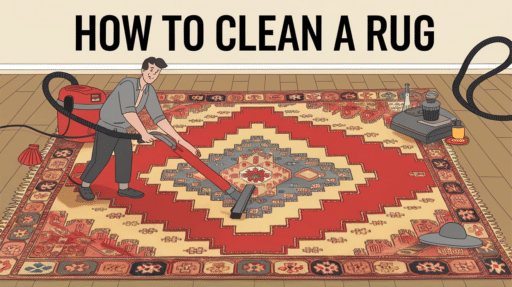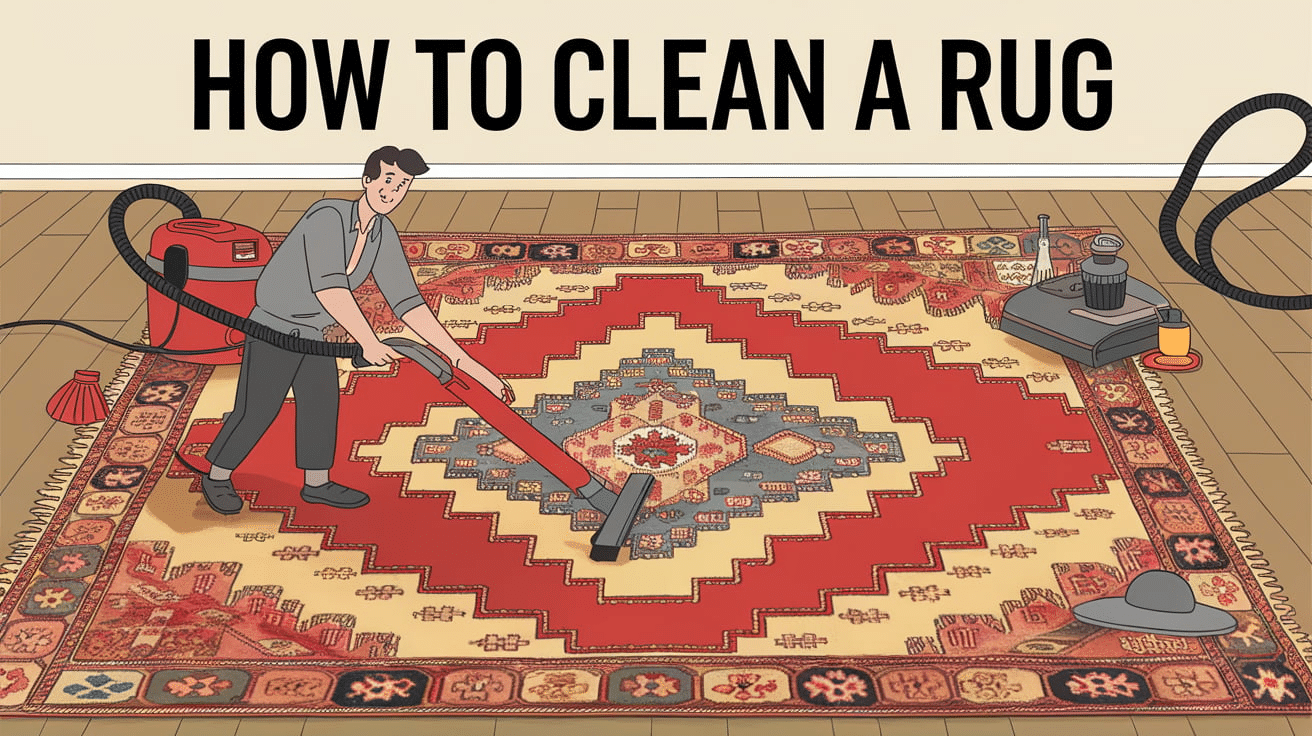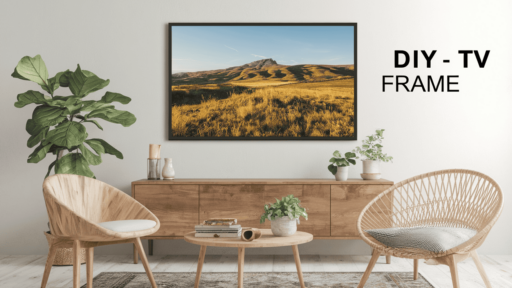Is your beautiful rug hiding beneath layers of dirt, pet hair, and mysterious stains? Don’t worry—you’re not alone in the struggle to keep your floor coverings fresh and lively.
Rugs anchor our living spaces and absorb the brunt of daily life, from muddy footprints to spilled coffee and everything in between.
The good news is that cleaning your rug doesn’t have to be a dreaded chore or an expensive professional service. With the right techniques and a little know-how, you can restore your rug’s original beauty and extend its lifespan significantly.
This guide will walk you through effective cleaning methods designed for your specific needs, whether you’re dealing with a soft Oriental heirloom, a plush wool statement piece, or a practical synthetic area rug.
From routine maintenance to tackling stubborn stains, we’ll cover everything you need to know to keep your rug looking its best.
Why Do Rugs Need to Be Cleaned?
Rugs act as giant filters in your home, trapping dust, allergens, bacteria, and debris deep within their fibers.
Without regular cleaning, these particles can accumulate, leading to indoor air quality issues and potential health problems, especially for allergy sufferers.
Beyond health concerns, dirt particles have edges that gradually cut and wear down rug fibers when walked upon, significantly shortening your rug’s lifespan.
Regular cleaning also prevents stains from setting permanently, maintains the rug’s appearance, preserves its color vitality, and extends its durability. A clean carpet is healthier, more beautiful, and will serve you longer.
The Importance of Regular Rug Maintenance
Regular rug maintenance keeps your home clean and helps protect your investment. Over time, dirt, oils, and spills accumulate, making rugs look worn and faded.
By regularly cleaning your rug, you remove dirt particles before they embed into the fibers, preserving the rug’s texture and appearance.
Professional cleaning can also help remove deep-set stains and prevent permanent damage. Additionally, cleaning enhances the overall atmosphere of your home by improving air quality and reducing allergens.
Taking care of your rug with routine cleaning ensures it remains comfortable and long-lasting.
How To Clean a Rug?
To clean a rug at home, start by thoroughly vacuuming both the top and bottom to remove dry soil and debris. This step is essential for effective cleaning.
Next, mix a cleaning solution in a garden sprayer, using a product like Zep’s Area Rug Cleaner, and spray it evenly across the rug.
Let it sit for 10-15 minutes to allow the solution to loosen the dirt. Afterward, gently scrub the rug with a soft-bristled brush to agitate the fibers.
Use a carpet cleaner with warm water to rinse the rug, making sure to extract as much dirt and cleaner as possible. Keep extracting until the water runs mostly clear.
Finally, dry the rug with a fan to ensure it dries quickly and evenly. If necessary, use a squeegee to remove excess moisture.
Materials Required to Clean a Rug at Home
Cleaning your rug at home doesn’t need professional equipment or expensive chemicals. With a few simple tools and some elbow grease, you can restore your rug’s beauty and remove dirt, allergens, and stains.
Vacuum Cleaner – A vacuum cleaner is essential for thoroughly removing dry soil and debris from the rug’s top and bottom.
Garden Sprayer – A pump-up garden sprayer is a great tool for applying cleaning solution evenly across the rug. It allows you to mix your cleaning agent and water in one container.
Cleaning Solution – Use a mild, store-bought area rug cleaner like Zep’s Area Rug Cleaner, which can be found at big-box stores or online. Avoid using professional chemical cleaners as they might leave a residue.
Soft-Bristled Brush – A soft-bristled brush is useful for gently agitating the cleaner into the rug fibers, loosening dirt and grime.
Carpet Cleaner – A carpet cleaner, like the Hoover PowerDash Plus, helps rinse and extract dirt and cleaning solution from the rug with fresh water.
White Towel – A clean white towel is helpful for testing whether the rug is clean. Gently scrub a section of the rug to check if any dirt transfers.
Squeegee – If you plan to power-wash your rug, a squeegee can remove excess water from its surface to speed up the drying process.
Fan – To help the rug dry quickly, use a box fan or any fan that provides good airflow over the rug to aid in evaporation.
These materials are easily accessible at stores and can help you clean your rug efficiently without any professional equipment.
Cost And Consideration
Here’s a simple table outlining the estimated cost of the materials required to clean a rug at home:
| Material | Estimated Cost (in USD) |
|---|---|
| Vacuum Cleaner | $100 – $250 (depending on model) |
| Garden Sprayer | $10 – $20 |
| Cleaning Solution (Zep’s Area Rug Cleaner) | $10 – $20 |
| Soft-Bristled Brush | $5 – $15 |
| Carpet Cleaner (Hoover PowerDash Plus) | $100 – $150 |
| White Towel | $5 – $10 |
| Squeegee (Optional) | $5 – $10 |
| Fan (Box Fan or Snail Fan) | $20 – $50 |
Total Estimated Cost
- Without Carpet Cleaner and Squeegee: $135 – $310
- With Carpet Cleaner and Squeegee: $235 – $510
The costs can vary based on the brand, store, and region, but this table provides a general idea of the investment needed to clean your rug at home.
Cleaning a Rug at Home: A Complete DIY Step-by-Step Guide
Step 1: Vacuum the Rug Thoroughly
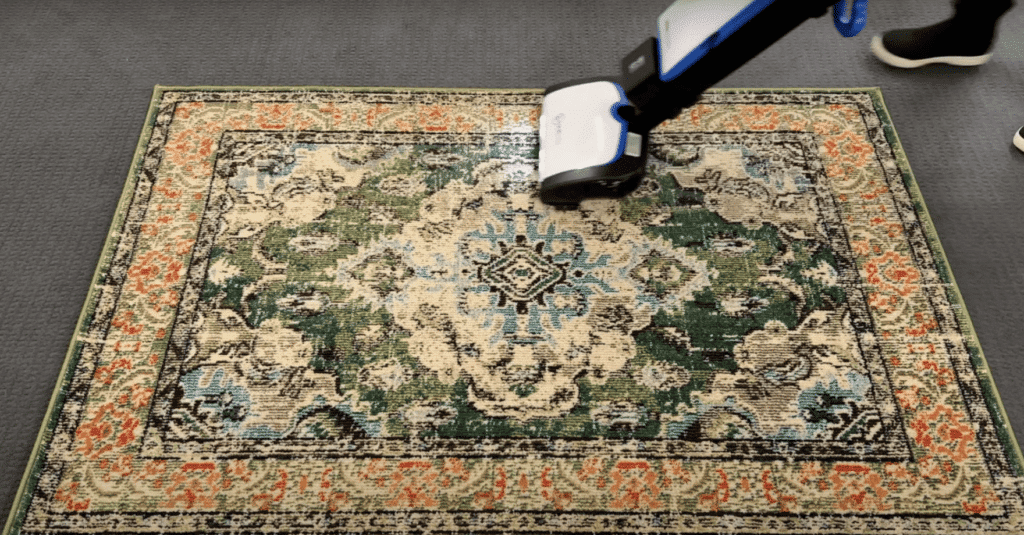
The first and most important step is to vacuum the rug, both on the top and bottom. This helps remove as much dry soil and debris as possible before wetting the rug.
Vacuuming properly prevents dirt from embedding into the fibers and makes cleaning much easier. A 360-degree vacuuming pattern works great, especially for shag or high-pile rugs, ensuring all sides of the fibers are cleaned.
Step 2: Mix Your Cleaning Solution

Mix your cleaning solution using a garden sprayer. Avoid putting soap directly into the carpet cleaner tank, as this can leave behind a sticky residue that attracts dirt.
A product like Zep’s Area Rug Cleaner is a good option and can be found at big box stores or online. Mix the cleaner with water in a garden pump sprayer and spray the solution evenly across the entire rug. Allow it to sit for 10-15 minutes to loosen dirt and grime.
Step 3: Agitate the Cleaner
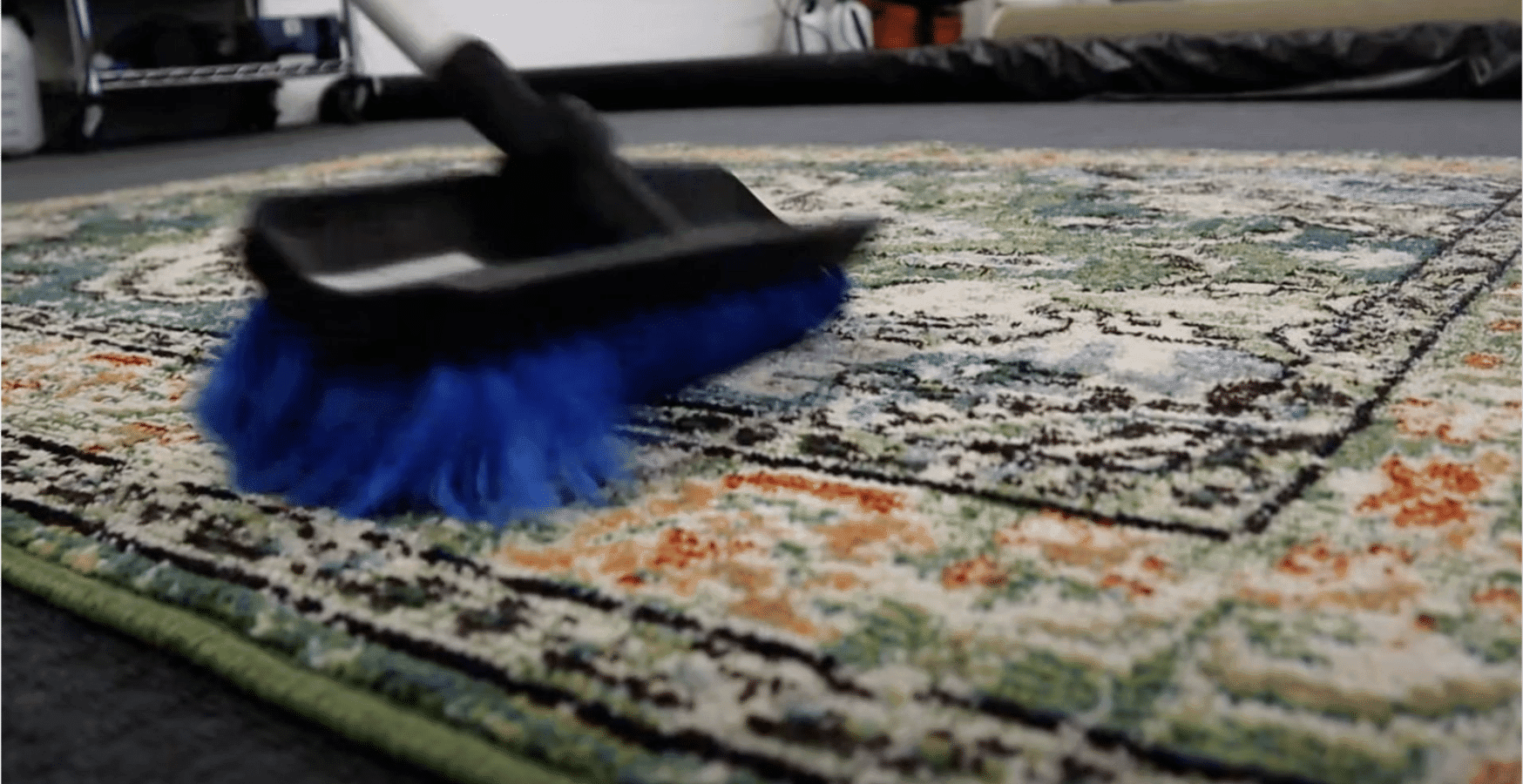
After the cleaner has had time to sit, grab a soft-bristled brush and gently scrub the fibers. This will help agitate the dirt and allow the cleaning solution to work deeper into the rug’s fibers.
Be gentle to avoid damaging soft fibers but thorough enough to lift dirt from the fibers.
Step 4: Use a Carpet Cleaner
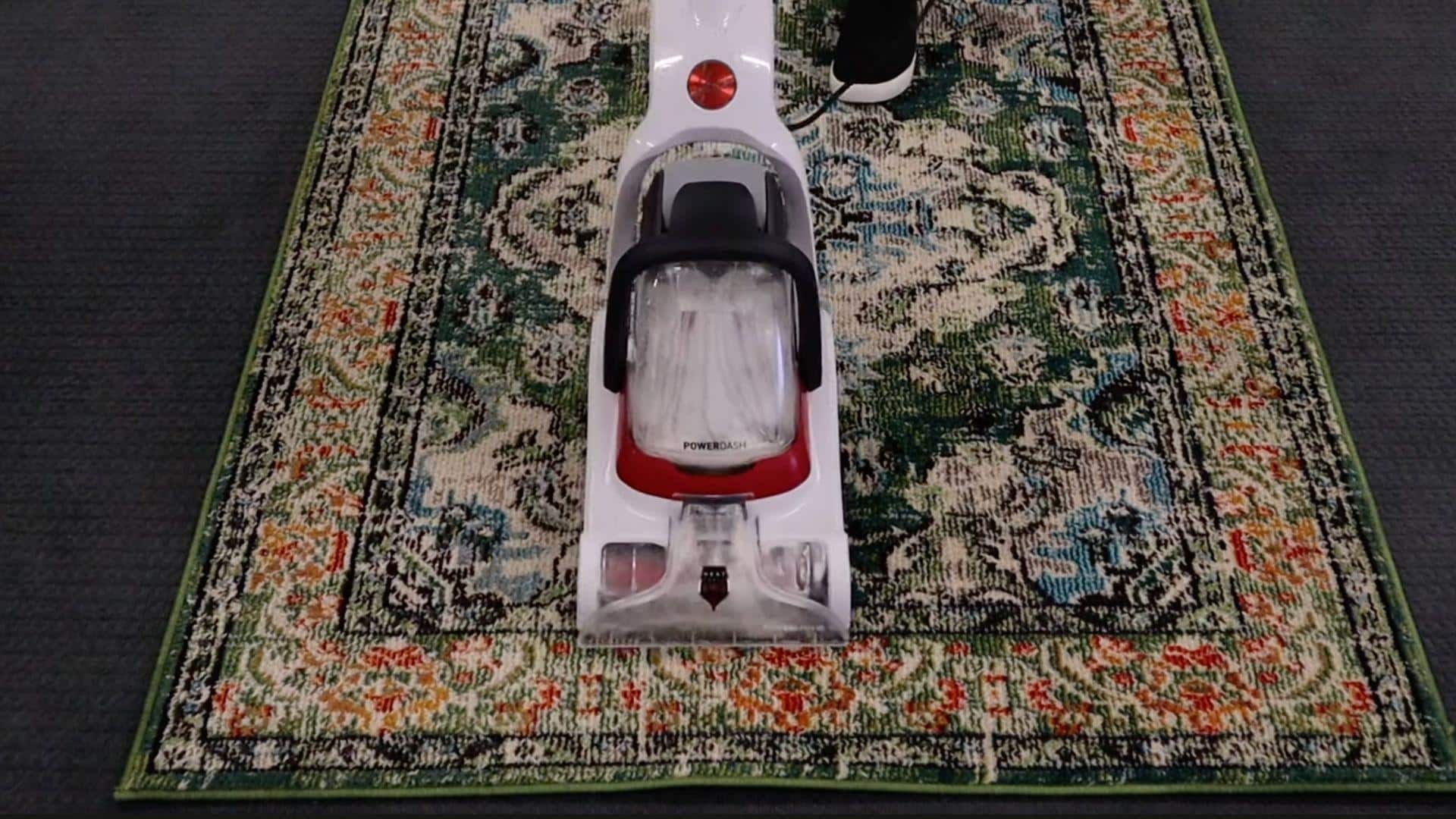
Now it’s time to rinse the rug and remove the dirt and cleaning solution. Use a carpet cleaner like the Hoover PowerDash Plus, which is affordable and does a great job.
Fill the tank with only warm water (no cleaning solution) and use the carpet cleaner’s trigger to apply fresh water to the rug.
Be careful not to over-wet the rug; only use water when pushing the machine forward and release the trigger when pulling it back. This method ensures the water gets sucked back up effectively.
Step 5: Keep Extracting Until Water Runs Clear

It’s important to keep extracting water until it runs as clean as possible. While your water might never be crystal clear, monitor the water coming out of the machine.
If the water looks clear, your rug is clean. To double-check, take a clean white towel and gently scrub a small section of the rug. If the towel picks up dirt, continue rinsing until the towel stays clean.
Step 6: Dry the Rug
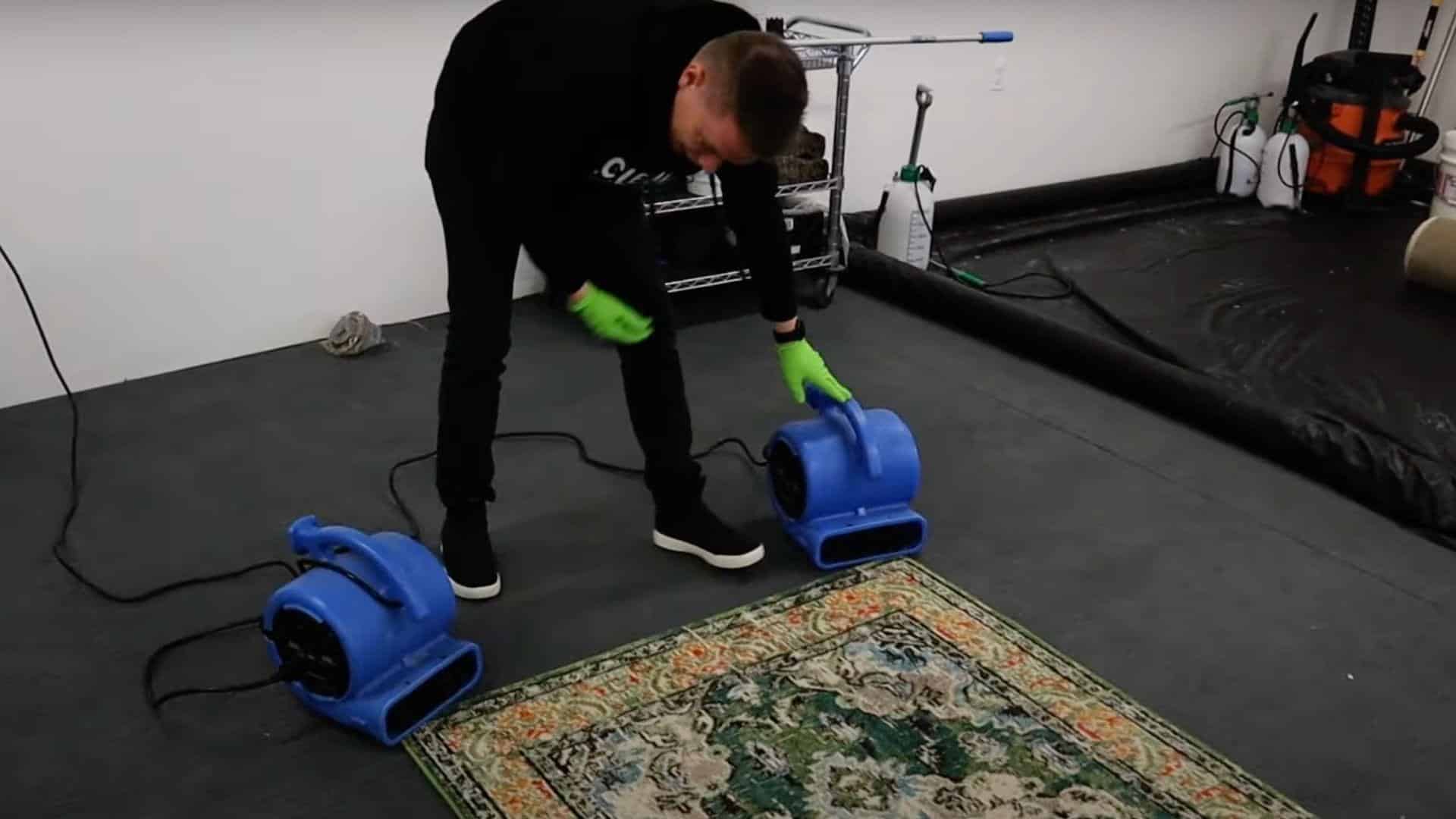
Once the rug is cleaned, the drying process begins. Use a fan, preferably a box fan, to ensure proper airflow over the rug. The key is to speed up evaporation, allowing moisture to leave the rug quickly.
Ensure both sides of the rug are exposed to airflow to help it dry faster. If you have a larger rug, it may take longer to dry, so be patient.
Video Tutorial for Cleaning a Rug
For more information, check the video tutorial by Clean That Up
Maintenence To Clean a Rug
Maintaining and cleaning a rug at home doesn’t require professional tools, but it does demand the right approach. Start by thoroughly vacuuming both sides of the rug to remove dry soil and debris, ensuring a deep clean.
This step is crucial as it makes the subsequent cleaning much easier and more effective. Once vacuumed, mix a cleaning solution with water in a garden sprayer and spray it evenly over the rug.
Allow the cleaner to sit for 10-15 minutes, giving it time to loosen trapped dirt. For tougher stains, use a soft-bristled brush to gently agitate the fibers, ensuring the cleaner reaches deep into the fibers.
When rinsing, use a carpet cleaner like the Hoover PowerDash Plus to extract dirt and cleaner without over-wetting the rug.
Finally, dry the rug using a fan to promote airflow and ensure quicker drying. Regular maintenance and cleaning extend the life of your rug and keep it fresh.
What Should You Prefer, DIY or Professional?
DIY Rug Cleaning
| Pros | Cons |
|---|---|
| More cost-effective; only requires basic cleaning supplies. | It can take longer, especially for large rugs or tough stains. |
| Flexible and can be done at your convenience. | It may not be as effective for deep-set dirt or stains. |
| Great for regular upkeep and minor stains. | Risk of damage if the wrong products or techniques are used. |
| No expertise is needed, just basic knowledge suffices. | Results may not be as thorough compared to professional cleaning. |
Professional Rug Cleaning
| Pros | Cons |
|---|---|
| Deep, thorough clean, especially for tough stains and allergens. | Higher cost due to labor and specialized equipment. |
| Professionals have the right tools and expertise. | Requires scheduling, which can be less convenient. |
| Saves time and effort, as it’s quicker and more efficient. | Not ideal for routine maintenance or minor cleaning needs. |
| No need to worry about the right products or techniques. | You must rely on a professional’s availability. |
In summary, DIY rug cleaning is budget-friendly and flexible but may lack the depth of professional cleaning.
On the other hand, professional services ensure a thorough and effective clean but come with higher costs and require scheduling.
Conclusion
Keeping your rug clean is easy if you know how! You need simple tools like a vacuum, brush, and cleaning solution. Clean rugs regularly to remove dirt, dust, and germs that can make you sick.
Start by vacuuming both sides of your rug to remove loose dirt. Then, spray cleaning solution and let it sit for 10 minutes. Use a soft brush to scrub gently. Rinse with water using a carpet cleaner until the water runs clear.
Dry your rug with a fan to prevent mold. Regular cleaning helps your rug look better and last longer. It also makes your home healthier by removing allergens.
You can clean rugs yourself or hire professionals for tough stains. The most important thing is to clean them often so they stay fresh and beautiful.

